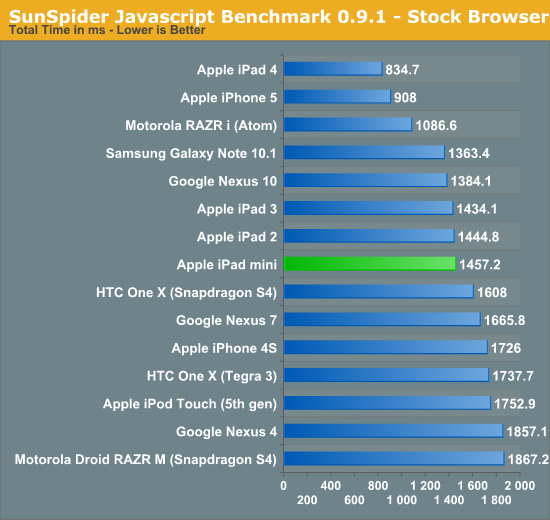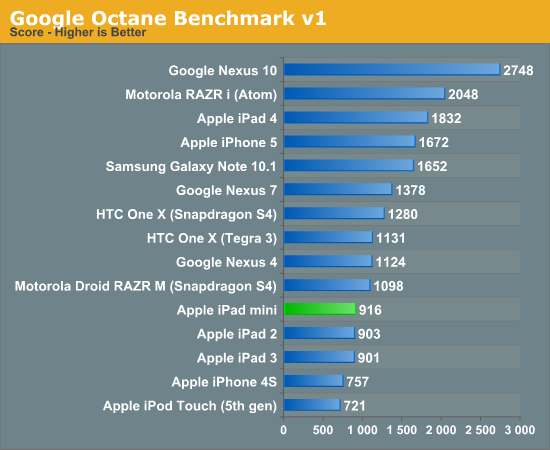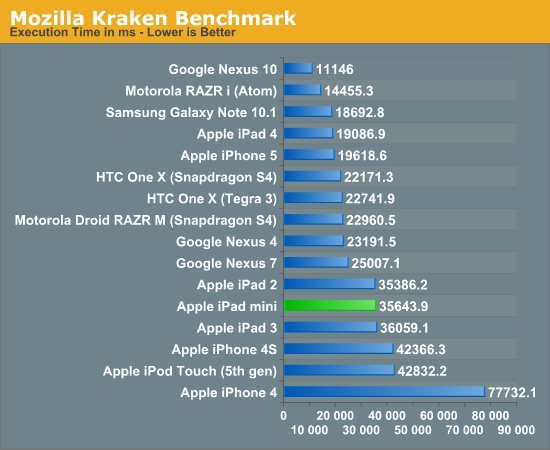iPad mini Review
by Anand Lal Shimpi & Vivek Gowri on November 20, 2012 6:10 PM ESTCPU Performance
As I mentioned before, the bulk of the innovation in the iPad mini is around form factor - the hardware platform itself is mostly a reuse of previous designs to keep costs low. The mini retains the 32nm A5r2 SoC as the iPad 2,4 and 5th gen iPod Touch. Despite the smaller size, it also uses the same 1GHz CPU clocks as its bigger brother. Performance is thus identical to the iPad 2,4, and a bit faster than the iPhone 4S. I found that the increase in clock speed does help to mask the fact that this isn't a Swift based platform, although going between the iPad mini and 4 does reveal an appreciable performance difference.
We're still very limited in good, cross-platform CPU benchmarks. We, once again, turn to JavaScript tests run in the browser. For all of the tablets tested here we're using Chrome for Android and Mobile Safari for iOS.
SunSpider has been a part of all of our mobile performance testing for quite a while now. It's not the perfect benchmark, but the test ends up being a good measure of browser performance as well as cache latency and CPU performance.

The iPad mini's two Cortex A9 cores running at 1GHz give it performance that is pretty much identical to the iPad 2 and 3, which also feature the same CPU. In the grand scheme of things however, the mini's performance is decidedly last generation. That's not to say that it's bad, it's just that the Swift based architecture in the A6/A6X is significantly better.
Google's Octane benchmark is a much larger test than SunSpider, but we're still looking at JavaScript performance. Octane includes all 8 of the tests from Google's older V8 benchmark but adds 5 new ones including a PDF reader, 3D bullet physics engine and portable 3D game console emulator all built in javascript.

Here the mini shows its age a bit, but mostly because of its conservative CPU clock speeds. Google's Nexus 10 is finally able to flex its muscle here and show just what the Cortex A15 is made of, even outperforming Intel's Atom in the RAZR i. Also note the performance increase compared to the iPhone 4S/iPod Touch, that's purely due to the clock speed advantage (1GHz vs 800MHz). I don't believe Apple picked the wrong clocks for the A5 in the mini as battery life remains a primary concern for this device.
Finally we have Kraken, a seriously heavy javascript benchmark built by Mozilla. Kraken focuses on forward looking applications that are potentially too slow to run in modern browsers today. The result is much longer run times than anything we've seen thus far, and a very CPU heavy benchmark:

Once again the mini equals the performance of the iPad 2 and 3, but remains appreciably slower than the iPad 4/iPhone 5. Google's Nexus 10 absolutely dominates in this test, continuing to outperform Intel's Atom based RAZR i.











140 Comments
View All Comments
MadMan007 - Tuesday, November 20, 2012 - link
Here's another display-related thing to fix: the charts for Brightness (black and white) and contrast don't include the Nexus 7 for some bizarre reason..hmm...but the later charts on the same page 4 do.Anand Lal Shimpi - Tuesday, November 20, 2012 - link
Fixed, thank you :)Take care,
Anand
ksherman - Tuesday, November 20, 2012 - link
While I understand where you're coming from, the reason the Nexus is zoomed in is because the Nexus "fakes" it's resolution in the web browser to about 603 so that responsive web pages render elements larger so they're easier to use on the Nexus 7. So the side by side photo is simply comparing the default view on load.In fact, this is actually somewhat of a negative for the iPad Mini on responsive sites because it means it's rendering pages designed for a much larger display.
Source: http://www.lukew.com/ff/entry.asp?1663
MadMan007 - Wednesday, November 21, 2012 - link
Now this would be something interesting to investigate and inform readers about. I didn't know about different devices presenting different resolutions and am not sure what the differences really mean.Galatian - Tuesday, November 20, 2012 - link
As a medical student I fast pretty fast in preordering the cellular white iPad mini here in Germany. It is the perfect size to fit into a white coats pocket. I will read a lot of books on it, so it was a hard decision between this and the 4th Gen iPad. But size does matter and eventually Retina will come to the mini line. For right now I just have to live with the resolution.Granseth - Tuesday, November 20, 2012 - link
This is a big issue for me with the Ipad 2, and it will be the same with Ipad mini. When I try to use the Ipad2 as a productive device I often lose information I write because the webpages and apps has to reload when the device gets out of memory and have to free something to load the next app/webpage. And this has become much worse as the Ipad has aged, so it's terrible that they are selling a new device with only 512MB of RAM.But hopefully people will use this smaller device as a consumption device, and not a productivity device.
ratte - Tuesday, November 20, 2012 - link
Excellent review as always, balanced and informative.It's a pity that Apple can't easily go to an intermediate resolution like 1600 x 1200, like Android can, but is stuck with the rezdoubling. For me the mini would have felt more futureproof if they had used an A6 with 1Gb memory. but then this is Apple....
MadMan007 - Tuesday, November 20, 2012 - link
Yeah, they need something obvious but AWESOME to make sure everyone buys a new one next year.Gaugamela - Tuesday, November 20, 2012 - link
Now it's easy to understand why Apple wanted to ban the Galaxy Tab 7.7. The iPad Mini is a rip-off of it. With a much worse display since the GT7.7 had a Super Amoled + display of superior resolution.Samsung was a year ahead of Apple and it still holds up great, if Samsung updated it to Jelly Bean.
I would like to see a new Galaxy Tab 7.7.
And the display is a disapointment. It makes it a no buy device instantly, it's 130$ more expensive than the Nexus 7 and offers a worse display. Anyone that picks the Mini should only do it by the form factor or preference by iOS.
ltcommanderdata - Tuesday, November 20, 2012 - link
The form factor is why I'm considering the iPad Mini over the Nexus 7. It has great build quality, is thinner, lighter, yet has battery life that is similar or better and has a screen that's a third larger. The Nexus 7's advantage in screen resolution in itself is not as important for me because the screen is smaller so showing more tiny content isn't useful. The lower pixel density is a concern for clarity. The CPU may be weaker, but the GPU is stronger which given good GPU acceleration for UI responsiveness is a reasonable exchange. $130 more maybe worth it if the better form factor makes the device more useable so that it sees more use.